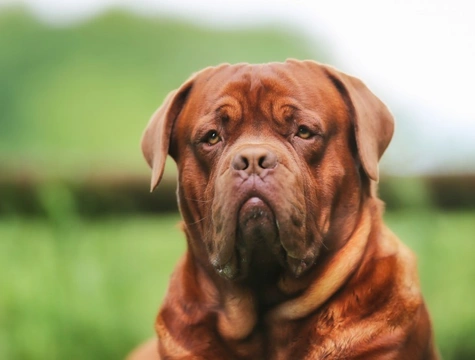
How to tell if your Dogue de Bordeaux’s coat is healthy
The Dogue de Bordeaux is a large and very business-like looking dog breed from The Kennel Club’s working grouping, and most of us first got to know the breed as a result of watching the old film “Turner and Hooch,” from which the titular Hooch was a Dogue de Bordeaux.
Dogues de Bordeaux have a short, fine coat that is actually very soft to the touch, and that sheds moderately throughout the year, which is not hugely high maintenance but that still benefits from brushing and grooming as well as the occasional bath to keep it in good condition.
However, the Dogue de Bordeaux is a fairly complex dog breed to manage and care for, and all owners or prospective owners of dogs of the breed need to be aware of the various health problems that can affect their dog’s health and longevity. One of the health conditions that the Dogue de Bordeaux is more prone to than most is issues with the skin and coat – such as sensitivities, allergies, and dermatitis.
If you already own or are considering buying a Dogue de Bordeaux, it is important to learn as much as possible about the breed and some of the possible challenges that face owners – including skin problems. But how would you be able to tell if your Dogue de Bordeaux’s coat and skin are healthy and in good condition?
In this article we will explain what to look for, and how to spot coat and skin problems in the Dogue de Bordeaux in the making. Read on to learn more.
Knowing the breed norms, and your dog’s normal coat
First of all, before you can assess the state of your Dogue de Bordeaux’s own coat, you need to get to know the breed’s norms in terms of what the coat looks like, and how it feels. Every dog is of course different, but there is a lot of uniformity too across this breed and how their coats look, as well as their texture.
You will also get to know your dog’s own coat appearance and texture very well over time, which can help you to spot any changes – which are often the first indication you will get of something amiss.
Coat shedding – what is normal?
The Dogue de Bordeaux is a moderate shedder, which means that they will shed hair to a certain extent all year round, and you will probably be aware of this due to shed fur in the house, and loose fur coming off when you pat your dog.
In spring and autumn your Dogue’s coat will tend to shed more heavily as they get ready for the changing weather, so if your dog seems to be shedding more heavily than normal, think about the time of year and the weather too before you assume it is a problem.
However, if your dog seems to be shedding overly heavily all of a sudden and it doesn’t seem to be seasonal, and particularly if their fur starts to look sparse or thin, this may indicate an issue.
The coat’s appearance
The Dogue de Bordeaux’s coat is straight, short, and lies flat. It should look clean and slightly shiny or glossy, and never dull, dry or uneven.
A Dogue de Bordeaux with a dull coat may not be getting the appropriate nutrition from their meals, or they may have a skin condition or allergy that is in its turn affecting the appearance of the coat.
The way your dog’s coat feels
How your dog’s coat feels can tell you even more than how it looks – and the breed’s fur should be smooth and soft to the touch, but not fluffy or plush. If your dog’s fur appears brittle, rough, or harsh, this usually indicates that something is wrong, but be aware of natural variations across different dogs of the breed, which can sometimes account for the variance.
Again, the key to identifying coat problems in the Dogue de Bordeaux begins with changes, and so if your dog’s coat appears to be becoming weak and less healthy-feeling, get this checked out.
Checking the skin
You can’t monitor and manage a dog’s coat without also taking into account their skin, because healthy fur does of course start with healthy skin.
Your Dogue’s skin should be clean, smooth and healthy looking, without dull, flaky areas, hot spots or rough or irritated patches. The Dogue de Bordeaux has quite loose skin, which means that they have skin folds that can occasionally become sore and irritated, although this is not as prevalent as it is in other more wrinkled breeds.
If you spot any problems with your dog’s skin or anything different to the norm, ask your vet to check it out to make sure there’s not something wrong.
Use your nose!
Finally, whilst dogs might not smell like the finest cologne, they shouldn’t be stinky either. A dog that is bathed and groomed regularly enough should not have a dirty or smelly coat – nor leave your hand with a distinctive “dog smell” if you pat them.
Skin conditions, muck, congested skin and even things like fungal infections can cause your dog’s coat to smell – as can dental problems that cause bad breath, because your dog licks their coat and transfers the smell across.
If your dog starts to smell funky within a couple of weeks of a bath when they haven’t done anything to warrant it, again, you should ask your vet to investigate as there might be a problem causing the odour.



